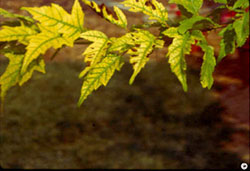
What is iron chlorosis?
Iron chlorosis is a term describing leaf yellowing (lack of chlorophyll) due to insufficient iron. Iron is a mineral essential for plants to make chlorophyll, in turn needed for photosynthesis. Lack of iron in a tree may be due to a high iron need, less effective iron uptake, or insufficient usable iron in the soil. Colorado soils generally have adequate to high iron levels, as evidenced by the many red soils and rock formations. However, Colorado soils are mostly alkaline, causing most of the iron to be in an insoluble form not usable by plants.
Symptoms of iron chlorosis are:
- newest leaves towards ends of branches are generally yellowed
- veins of affected leaves remain green
- in advanced cases, leaf edges become scorched and leaf interiors show dead brown areas as cells die

What makes iron chlorosis worse?
Insufficient soil oxygen or anything that affects root function in the soil can worsen iron chlorosis or cause it to appear in less chlorosis-prone trees. Compacted clay soils and overwatering can both result in lowered levels of soil oxygen. Sometimes, where planting density is high or there are other plants competing for water and minerals, trees may develop iron chlorosis. When plants are over fertilized with phosphorus, iron chlorosis may develop as roots take up phosphorus to the exclusion of iron.
What trees are susceptible to iron chlorosis?
Some locally-used trees that often develop iron chlorosis include maples (red, silver, Amur), oaks (red, swamp white), aspen, apple/crabapple, peach and some pines. When soil pH is above 7.5 the best control for iron chlorosis is to avoid trees that will be sensitive to iron chlorosis due to alkaline soils.
There are several treatment approaches:
- add iron sulfate to soil – effectiveness may be limited
- add iron chelates to soil – some are more effective than others depending on soil alkalinity
- addition of sulfur to lower soil pH – less feasible when alkaline soils are high in lime
- iron sprays to foliage – often impractical, especially on large trees, effect is only temporary
- trunk injections – holes drilled in trunk may provide entry for disease organisms; best left to certified arborists
For more information, see the following Colorado State University Extension fact sheet(s).
For more information, see the following Planttalk Colorado™ script(s).



